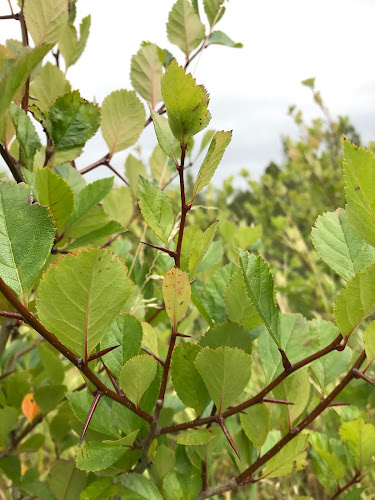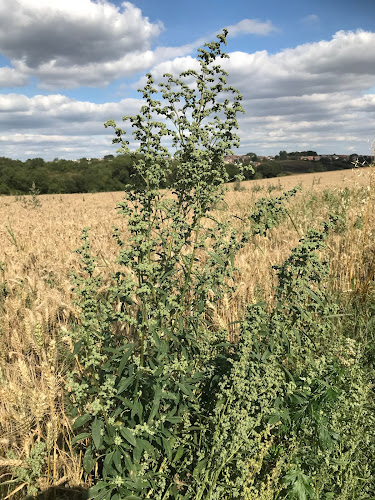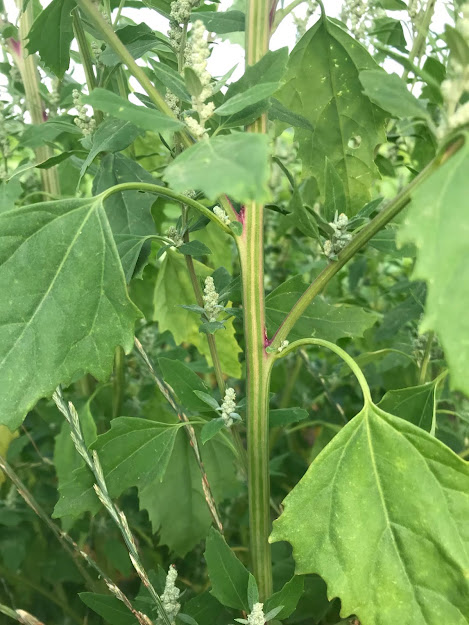I'm pretty sure that's the correct collective noun, although perhaps it should be confusion or conundrum. As acknowledged in Stace, and as obvious to anyone who has ever looked closely, this is a notoriously 'plastic' group of plants, with Fat-hen (Chenopodium album) particularly so and in all honesty a dumping ground for anything that can not be placed within the other accepted species. How many of us have felt unhappy recording the latter once we have appreciated its extreme variation? I know I have.
So the question is then, can any variants be recognised that are consistent and more than just oddities of local occurrence? That is where Sell & Murrell's recent classification comes in. I don't think anyone, Sell included, would expect this to be the definitive statement on the genus. Sell acknowledged that the genus has suffered from a lack of serious attention, probably more so than any other element of the British flora. But there are historic collections of the genus available for reference that at least allow us to come back at this group with a fresh pair of eyes. That is really what the Sell & Murrell classification is setting out, a first draft classification to be tested further, and ideally tested in the field rather than via the herbarium sheet.
I've been pondering this since 2018. Not rushing to record, just getting a feel for the variation. This year has given more time to look and collect photographs to go with initial identifications. This was assisted by a warm start to the year meaning that my local populations developed early and developed their stem colour (which is not a given this far north, stem colour is almost certainly not to be relied on), and a delayed harvest due to the wet summer that gave more time than usual to look.
Based on this, I am more and more confident that there are some distinctive entities that are worth recognition, certainly no less so than accepted species such as Probst's Goosefoot (Chenopodium probstii). It is these taxa I focus on in this post (as I understand them, feedback welcome). They are all relatively tall species that occur widely and seem relatively straightforward, especially when encountered as populations. They are species that are hard to define on paper (like so many species), but once seen in the field make sense. Hopefully others will have a look at their local populations and share details so understanding of this challenging group can solidify further.
Druce's Fat-hen (Chenopodium drucei)
Named of course for the eminent botanist George Claridge Druce. This is a distinctive species with ovate or rhombic lower leaves (sometimes irregularly dentate - these teeth are small), and typically comparatively long lanceolate obtuse to acute leaves in the upper part of the plant. The foliage is a rather dark dull green. The inflorescence is also distinctive (relative to some other species) being widely branching and drooping at the tip. Sell describes this species as 60cm tall based on apparently limited field experience of this species. Some populations I have found were taller than this, no doubt dependent on weather and growing conditions (and probably when it first germinated i.e. early or late season).
Lower leaves, note some have small teeth
Note that the upper foliage becomes more elongate (lanceolate)
Typical mature inflorescence
I have been finding this species widely scattered in arable districts south-east of Leeds (VC63 and 64) within walking distance from home (the limit of most of my botanical excursions this year). But still a reasonable geographic spread (red dots) covering more than one farm. Each grid square is a monad
Fallacious Goosefoot (Chenopodium fallax)
I found this medium to tall species in its 100's at the edge of a potato crop. Faced with such a large uniform population it seems inarguable. But it occurs more widely and seems relatively common. It has distinctive dark green foliage, of relatively large size and held in a characteristically drooping way such that the foliage looks dense. The distinctive leaves have a triangular central lobe and typically a pair of lobes at the base (perhaps better described as lobe-like teeth). The inflorescence is relatively lax (compared with other species) but not as lax as Druce's Fat-hen. The only similar (and more widely accepted) species in Sell & Murrell is Maple-leaved Goosefoot (
C. acerifolium), but I am not convinced that the definition of that species matches the understanding of this species in other countries.
Typical foliage from bottom of plant to top (left to right)
Foliage
Arrangement of the inflorescence (upper plant is paler as it has set seed and is going over)
Eastern Fat-hen (Chenopodium pseudostriatum)
Another medium to tall species, and perhaps the most common. When this plant loses its larger leaves, as most fat-hen species do later in the season, it would be easily mistaken for Striped Goosefoot (Chenopdium striatum). That may explain its name. The latter species never has the large and obviously toothed leaves of this species, but you could easily envisage it as one of the potential parents of Eastern Fat-hen, and something like Fallacious or Probst's Goosefoot as the other parent.
The best jizz for this species is the pale green foliage, oblong to ovate and denticulate on the lower plant (but no basal lobes), and untoothed and linear to lanceolate towards the top of the plant. It is usually quite a narrow plant. The stem can develop prominent red striping (in a good year, this seems unreliable in Yorkshire where I have known this species for several years). The inflorescence is much more dense than in the above species.
Typical growth form and inflorescence
Typical foliage from bottom to top of plant, affinities with other species but the plant as a whole is very different
Probst's Goosefoot (Chenopodium probstii)
So having looked at the above, what about an 'accepted' species. Some might describe it as nondescript in comparison.
It seems genuinely rare so is probably only a casual. I have found it by a muck heap and on land disturbed for construction of a motorway service station. I would be far less confident in my ID if there was not some good herbarium material online to compare against.
See here.
This can be a tall species, but I don't think this should be relied. The foliage is a relatively pale green and has a very blunt (rounded obtuse) apex. All leaves are toothed, can develop a red margin, and the lower ones hang on relatively long petioles.
Lower leaves
Upper leaves


















































